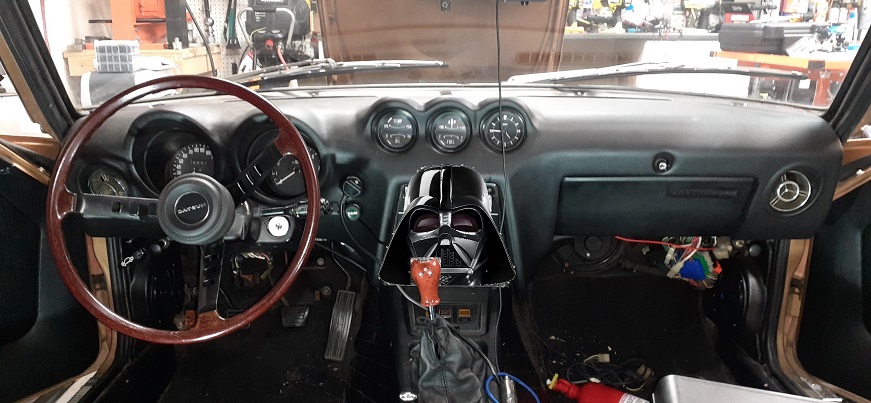Everything posted by Captain Obvious
-
Bypassing ballast resistor?
From 74 through 77 they used a 0.5 Ohm coil and a 1.3 Ohm ballast resistor. Then from 78 through 83 they used as 1.0 Ohm coil and no ballast resistor, but they also put an "on-purpose" coil current limit built into the ignition modules. Pre-78 modules had no such feature. So Datsun wanted the 74-77 modules to be paired with a 1.8 Ohm resistor (except when cranking in START), and they wanted the 78-83 modules to be paired with a 1.0 Ohm resistor. I assume those pairings were somewhat derived through experimentation and analysis at their end. So I'm no ignition expert, but here's my read getting to the meat of your question.... "Is it OK to run the ZX matchbox module (which was intended to be paired with a 1.0 Ohm coil) with a 71 coil instead?" I just took a look at the 72 FSM and it says the coil resistance is 1.6 Ohms. Using a 1.6 Ohm coil with the ZX module would result in the coil current being lower than as-designed, but if it runs OK and doesn't break up at higher RPM, then I'd let it be.
-
74 260 Hesitates/runs poorly above 3500rpm in 1st and 2nd after car has heat soaked - runs great for first 30-40 minutes
That's ridiculous. Nobody in their right mind does that.
-
Bypassing ballast resistor?
The original ballast resistor nominal is 1.3 Ohms . And the original coil spec is 0.5 Ohms. The total nominal resistance of the two in series is 1.8 Ohms. (Page EE-45 of the 75 FSM) I'm thinking that with a 1.5 Ohm coil and no ballast resistor, you're very close to stock. You've just moved the resistances around. And since everyone likes pics:
-
74 260 Hesitates/runs poorly above 3500rpm in 1st and 2nd after car has heat soaked - runs great for first 30-40 minutes
Haha!! Yeah, I got all excited when I saw someone working on a 260. Then I saw the note about the round tops.
-
74 260 Hesitates/runs poorly above 3500rpm in 1st and 2nd after car has heat soaked - runs great for first 30-40 minutes
Round tops. Or I would have been involved at the start.
-
low oil pressure
What he said. And it doesn't matter whether you are tightening or loosening. The mechanics of the static friction are the same. I'm not trying to cast dispersions on your work, but what I'm saying is don't get all caught up in the absolute numbers you think you are seeing. I'm saying that just because YOUR wrench doesn't click until 50 ftlb on a fastener that was supposed to be torqued to an upper limit of 40 does not convince me that bolt was originally torqued higher than the spec. So you've got an engine with a bunch of time and heat cycles on it. And when you used your torque wrench (with some unknown accuracy), it took more torque than spec to move the bolts that have been in there for some time. No surprise there.
-
low oil pressure
I'm not a mechanical engineer, but I have serious reservations about using the torque required to crack a bolt loose to determine what said bolt was originally torqued to. I mean... I bet it's proportional (like the more it was torqued to, the more it would take to break it free), but as far as determining absolute value... I'm very skeptical. @Wally, You just torqued your main bolts to 38 ft-lb, right? Put your wrench back onto a couple of them and see what torque it takes to remove them. See if it takes 38, or if it takes more than that. I bet it takes more. Static friction is higher than sliding friction and all that?
-
air leak at throttle shafts
Well I have my doubts about the theory that those marks were from an attempt to expand the end of the shaft, but who knows. I wasn't there when they did that, but I would have expected that someone who thought they knew enough about such maneuvers would have done a better job. Forensic analysis from my comfy chair shows file marks on the end of the shaft. Further, the fact that the upset areas around the screwdriver divots do not exist, it would be my suggestion that the upset "burrs" around the craters were filed off. And since the shaft does not sit proud of the hole it is recessed in, that filing operation must have occurred after the impact operation. Presumably in an attempt to make it look better? LOL! Whatever happened, it's gruesome.
-
Differences between 240z and 260z dashboards
So out of curiosity, how did the leather dash people make the contours fit? Did they do it with sewn seams? Got any pics of one of them installed?
-
Differences between 240z and 260z dashboards
-
air leak at throttle shafts
I'm kinda confused by a couple things. First is... What are you considering a "new method" for sealing? If the new method is the use of steel bushings pressed into the carb body, then you are mistaken. That's not new. That's how the carbs have been produced all along. Steel bushings pressed into the bodies, and (presumably) honed to alignment and size after being put into place. In other words, the carbs never ran the throttle shafts directly against the soft aluminum of the body. There was always a steel sleeve in there. Second thing that confuses me is... Why?? I mean, I see there are clearly impact marks and someone broke both the body and the steel bearing with an inappropriate amount of poorly aimed force, but why? What would make someone resort to hammering on the end of the throttle shaft? Was it stuck SO bad in the body that was the only way they could get the shaft out??? Why???
-
Help! What are these engine sensors?
Those are cylinder head temp sensors for the ZX. Used on the P79 and P90.
-
Master cylinder anomaly
-
Master cylinder anomaly
Yup. We got into some of that in those threads I posted: https://www.classiczcars.com/forums/topic/66276-brakes-dragging/?&page=2 https://www.classiczcars.com/forums/topic/66168-brake-master-cylinder-identification/
-
Master cylinder anomaly
Any outlet restriction would not matter either*. The master cyl bore bore is the same diameter and the two circuits are in series. That means that at the master cylinder (and until downstream of the proportioning valve), It will be the same pressure in both circuits. The circuit closest to the firewall won't build pressure until the circuit towards the front of the car builds pressure (or bottoms out mechanically). In fact, neither circuit will build braking pressure until they both do (or one of the two bottoms out). Maybe there's something "safer" in having the main braking circuit (the front axle) be the one that builds pressure as the second circuit.. Or maybe there is less volume required to be moved in the drum brake circuit before the shoes contact the drum so they put that one at the front of the master cylinder? If so, it would take less pedal travel before the other circuit (front disks) builds pressure. Brake experts would know for sure. And that's not me. *Except on transient changes.
-
Rear Brakes Locked Up
Nice!!
-
Master cylinder anomaly
I don't have pics of the older style of master cylinder exploded, but this is what the later one (with the front circuit closest to the firewall) looks like: Here are a couple other threads with pics and significant discussion about master cylinder operation: https://www.classiczcars.com/forums/topic/66276-brakes-dragging/?&page=2 https://www.classiczcars.com/forums/topic/66168-brake-master-cylinder-identification/
- Proper Needle Jets for 72 3 screw roundtops?
-
1971 HLS30-14938 "Lily" build
That valve is supposed to be open when the piston is at rest (not pushed in) and closed when the piston is pushed in. In other words... When your foot is pushing the clutch pedal in, that valve is closed. It opens by catching on the little retaining pin you were questioning about the color. The function of that valve is allows fluid to fill the plunger area if necessary, but then close off when the piston starts to move so hydraulic pressure can build. The tip of the pin rides in that long groove, and when the piston is at rest, that pin pushes against a small weak spring and opens the valve. Valve closed: Valve open: Easy-peasy.
-
Carb Part needed 72 roundtop
There's no way I would trust epoxy on that. You need a replacement.
- Proper Needle Jets for 72 3 screw roundtops?
-
ZX rear caliper
Excellent! So I've got an EK hatch (I know it's not really an EK, but all the cool kids call them EK's). It's my daily and it's never intended to be the project. It looks like asss with failed paint and it's a slow pig, but I'm in it for the gas mileage, not for the performance. Only thing that annoys me is my prior daily was a First Gen Teg, and it was fun to drive. Not super-performance, but way better than my current Civic. And the thing is.... It got about one MPG MORE than my EK. Enjoy, and try to remember where the project time and money should go!! Haha!
-
ZX rear caliper
Haha!! How far from the original subject do we want to stray? With apologies to the OP....... I've got a 6th gen Civic (96-00). I always hated the steering ratio. Always felt like I needed to readjust my hands in the middle of a turn because I needed more wheel rotation. Got fed up one day and started experimenting... The pinion gear on the end of the power steering spool valve has eight teeth. The similar pinion gear from a third gen Integra (93-97) has NINE teeth (one more than the Civic). Problem is the spool valve bodies are different so you can't just toss the whole Integra body onto the Civic steering rack. However after poking around with both of them in my laboratory, I determined that the GUTS are interchangable. So it's a "simple matter" of pressing both valve assemblies apart and reassembling the Civic valve body using the Integra spool valve. Then reattach the modified spool valve onto the original steering rack and put in back in the car. "A child could do it." Take the valve off the rack: Pressing a spool valve apart on the hydraulic press: Spool valves. Integra on top. Civic on bottom. Note that the Integra has a tighter pitch on the gear: Pinion gears. Civic on left. Teg on right: How did it turn out? Fantastic. Would I do it again? If I had the sub-frame out - Maybe. If I wasn't going in for something else? - Absolutely not.
-
ZX rear caliper
Well that's my DD and not supposed to be the project, so I put as little time and effort into it as I can. LOL! So... The answer to the question about what engine did I put back in is "The same one that came out." I only pulled it because it needed work done on multiple sides of the engine and at that point I thought it was just simpler to pull the whole thing and do everything with the engine out. Belt side needed new timing belt. Bottom side needed oil pan gasket. Rear side needed new engine mount (taught kid how to drive stick). Transmission side needed new main seal and clutch, etc. So since I needed to work on left, right, rear, and bottom, I just pulled the whole thing out to do the work. I did do one "bonus" item... I pulled the subframe and put in an Integra steering gear for a faster steering ratio. But that car is not the project.
-
My 1978 280z Will Barely Run Help!
Over the past few years I've purchased a couple things from Spark Surplus and can attest for their legitimacy. I'm not sure where their "surplus" comes from, but they are a legit entity. Don't always know any details about what they have, but with that many auctions, who would?












